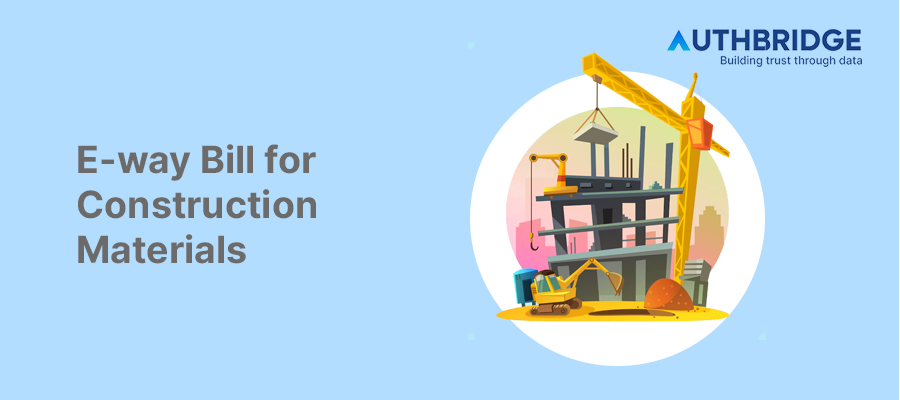Navigating E-way Bill Compliance For Construction Materials: A Comprehensive Guide

The E-way Bill (Electronic Way Bill) is a document required for the movement of goods exceeding a certain value threshold. It serves to ensure tax compliance and track the movement of goods across India, facilitating the smooth operation of the Goods and Services Tax (GST) regime.
Applicability and Threshold
The E-way Bill is applicable for any consignment with a value exceeding Rs. 50,000. This requirement covers both inter-state and intra-state transportation of goods. It's a critical tool for the government to prevent tax evasion and ensure goods are tracked from origin to destination.
E-way Bill for Construction Materials
Intra-site Material Movement
For the movement of construction materials within the same site, an E-way bill is typically not required, as this does not constitute transportation from one place to another in the context of inter or intra-state movement. This scenario is especially relevant for large construction sites where materials are frequently moved from one location to another within the same premises.
Inter-site and Interstate Movement
When construction materials need to be transported from one site to another, whether within the same state or across states, the E-way bill becomes necessary if the value of the goods exceeds Rs. 50,000. The transporter must carry the bill along with the invoice or delivery challan.
Documentation and Compliance
The required documents for transporting construction materials include the tax invoice or bill of supply, the delivery challan, and the E-way bill number (EBN), generated on the GST portal.
E-way Bill for Construction Equipment
Shifting Equipment Within State
- Delivery Challan and E-way Bill Generation: For shifting construction equipment like tools and plants within the same state for service work, a delivery challan along with an E-way Bill should be prepared if applicable. The necessity of an E-way Bill depends on the valuation of the equipment.
- GST Implications: There are no GST implications if the movement does not constitute a supply. However, documentation is crucial to substantiate the nature of the movement.
Shifting Equipment Across State
- Tax Invoice Requirement: For inter-state movements, a tax invoice should be issued, and GST should be paid on the taxable value, which is determined based on the nature of the transaction.
- GST Payment on Taxable Value: The GST payment is required if the equipment transfer is deemed a supply. The taxable value and the applicable tax rate depend on the specifics of the equipment and the transaction.
Practical Scenarios and Solutions
This section could include hypothetical scenarios that construction businesses might face, along with advice on handling these situations in compliance with E-way Bill regulations. Including expert opinions and referencing legal interpretations can provide readers with a deeper understanding of the practical application of these rules.
Compliance Checklist and Best Practices
Offering a checklist for businesses to ensure they are compliant with E-way Bill requirements can greatly benefit readers. This could include reminders about documentation, deadlines for E-way Bill generation, and tips for efficient record-keeping. Highlighting common mistakes and how to avoid them can also be invaluable.
Regulatory Updates and Changes
Stay updated with the latest amendments to the E-way Bill regulations and how they impact the construction sector. An analysis of these changes and their implications can help businesses stay compliant and avoid penalties.
Interstate Transfer and Tax Invoice
When construction materials or equipment are transferred across state lines, the transaction becomes subject to GST. The taxable value of the goods or equipment, as stated in the tax invoice, determines the GST rate applicable.
GST on Taxable Value and Exemptions
Certain exemptions may apply to the movement of construction materials and equipment, especially when it is for own use and not for supply. It's crucial to stay updated with the latest GST notifications and exemptions to ensure compliance.
Practical Scenarios and Solutions
Transporting Used and Old Machinery
For the interstate transportation of used and old machinery, preparing an E-way Bill along with a dispatch challan under the head "outward movement for own use" is recommended. This method does not require the generation of GSTR1 and is not taxable for interstate movement for own use.
Outward Movement for Own Use
This category specifically addresses the movement of goods that are not meant for sale or supply. It simplifies the documentation process and provides a tax exemption under specific conditions.
Category

Abhinandan Banerjee
(Associate Manager - Marketing)
Abhinandan is a dynamic Product and Content Marketer, boasting over seven years of experience in crafting impactful marketing strategies across diverse environments. Known for his strategic insights, he propels digital growth and boosts brand visibility by transforming complex ideas into compelling content that inspires action.



